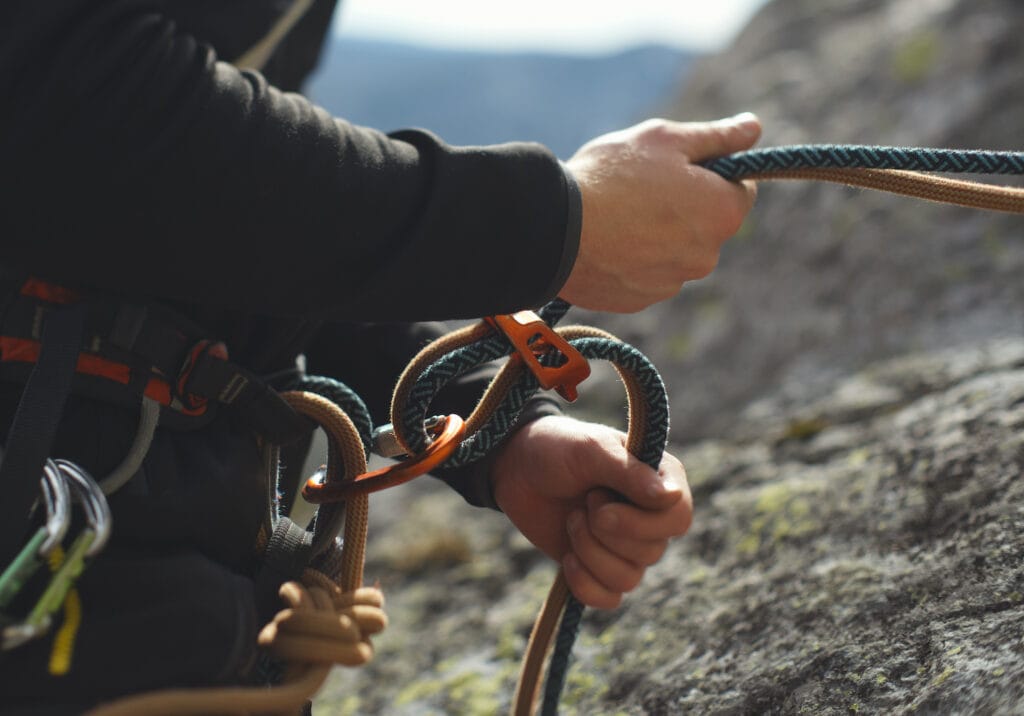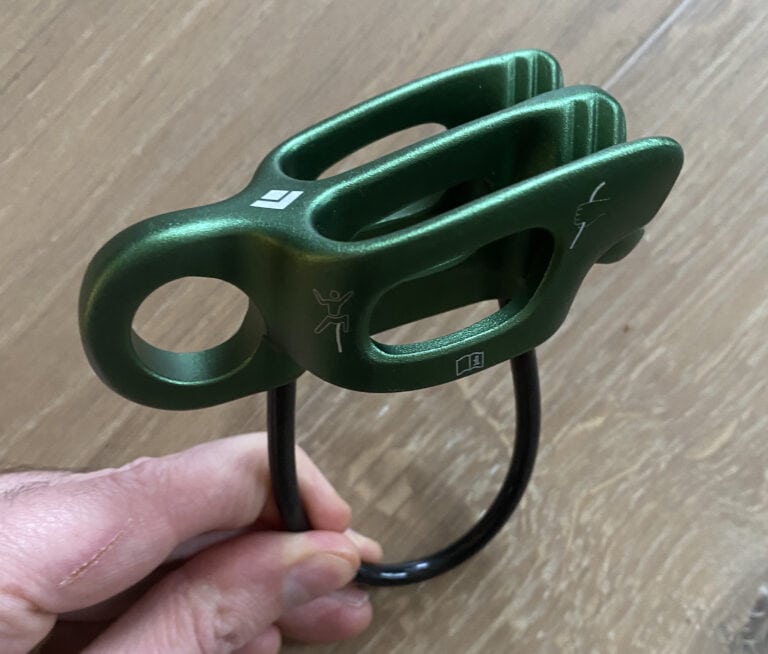What’s an ATC Climbing Device?

Published on: 11/06/2022
Climbing has come a long way since its old-school origins. This is especially true for climbing equipment, most notably – belay devices.
Back in the day, the proper belay technique was as simple as wrapping one rope around your waist (and maybe shoulders) to give a “hip-belay.” Unfortunately, belaying was so insecure that the safety guidelines for climbers were not to fall.
Since then, times have changed. Climbing and belaying have become much safer, mostly thanks to modern belay devices. The tube-style device, assisted braking devices, and other belay devices have changed the face of what it means to belay.
Keep reading to learn about the most iconic belay device– the Black Diamond ATC.
Belaying in Rock Climbing
The sport of climbing has evolved because belaying techniques and gear have become much safer. As a result, most climber falls are no longer catastrophic– so long as the belayer does their job, of course.

Because belaying is safer and falling while climbing has become normalized, climbers can push themselves into more challenging and more complicated terrain.
This progression in the sport of climbing, of trying harder and feeling okay to fall, has its roots implanted in creating one of the most reliable belay devices known to the sport– the Black Diamond ATC (1).
What Does ATC Stand For?

One of the climbing market’s most famous and trusted belay devices is the Black Diamond Air Traffic Controller or ATC.
Black Diamond’s most tried and true belay device was named the ATC to facetiously draw the connection between a falling climber and an aircraft trying to land at the airport.
The airport’s air traffic controller controls the aircraft’s safe landing. Similarly, in the climbing context, the belayer (and the belay device) are responsible for the climber’s safe fall.
Origins
The ATC by Black Diamond is a contemporary iteration of older tube-style belay devices.
Tube-style belay devices, also known as manual or tubular belay devices, consist of one or two tubes or elongated holes. The climbing rope is threaded into one or both of the tubes of the belay device.
In the 1970s, the first patented belay device was the Sticht Plate (2), named after Fritz Sticht. Later, the German climbing manufacturer Edelrid came up with the Bankl, which was directly inspired by the original slotted plate design.

In time, slotted plate devices like the Sticht gave way to the tubular device, also known as tubers (3). Tube-style devices became popular because they functioned better, dissipated heat, were small, lightweight, and wore evenly over time.
Finally, in the 1990s, the North American climbing manufacturer Black Diamond came out with a more modern belay device–the air traffic controller (4).
Inspired by older designs, the ATC improved on other devices with lighter weight, stronger materials, a plastic-covered keeper cable, and more ergonomic tube depths and widths.
How Does it Work?
Tube-style belay devices like the ATC control the speed of the rope by creating friction and providing an edge that a belayer uses to leverage the rope.
In top rope climbing, as the climber advances upwards, the partner belaying takes in slack and pulls the rope down over the edge of the ATC into the braking plane, so they are ready to arrest a fall.

When it’s time to lower the climber, the belayer modulates the pressure they grip the rope to adjust the speed at which their climber descends.
In lead climbing, the belayer pays out slack to the climber so they can advance upwards and clip pieces of protection, such as bolts and quickdraws, or traditional pieces of gear like camming devices and stoppers.
When it’s time to catch a fall or lower the climber, the belayer brings the brake strand of rope downwards towards their hip into the braking plane. The friction the ATC creates, along with pressure from the belayer’s grip, arrests the fall and allows them to lower the climber.

Loading an ATC Belay Device
One of the reasons why tube-style devices are so popular, especially the ATC, is because they are incredibly user-friendly. In other words, they are easy to use and double-check for safety.
- First, fold the climbing end of the rope to make a bite.
- Thread the bite of rope through the device using either of the two tubes making sure the climbing strand is on top and the brake strand is on the bottom.
- Capture the bite of rope and the keeper cable of the ATC with a locking carabiner.
- Attach the locking carabiner and ATC to the belay loop of the belayer’s harness.
- Lastly, lock the carabiner and double-check that the device is appropriately orientated and locked.
Best Uses for the ATC
The ATC is one of the most straightforward designs for a belay device on the market. Therefore, it can be relatively limited in how it’s used.
However, the ATC is often the go-to choice for beginner or veteran climbers who like to keep things simple.
The ATC is ideal for three types of climbing.
- Indoor or outdoor top rope belaying from the ground.
- Indoor or outdoor lead belaying of a lead climber.
- Rappelling to descend a single or multi-pitch climbing route.

Advantages and Drawbacks of ATC Belay Devices
There are many reasons why the ATC is the most popular belay device. Most climbers love it!
However, depending on the style of climbing you prefer (or want to get into) and the safety precautions you want to take, there may be drawbacks to the ATC that make it the incorrect device for you.
Advantages
- The ATC boasts a simple, compact, and lightweight design that is easy to use the proper way and double-check.
- It can accommodate various rope diameters and can be used with a single rope or two ropes, such as twin ropes.
- Typically, climbing ropes tend not to twist, especially thinner ropes.
- The ATC can be utilized for belaying and rappelling in sport climbing (indoor or outdoor) and traditional climbing contexts.
- The simple tube-style design is durable and requires very little maintenance if any at all.
Drawbacks
- The ATC does not have the additional metal loop that is required for belaying from the top of a climb in guide mode.
- ATC devices rely solely on proper installation, friction, and brake hand– they do not have a camming mechanism and are not considered assisted braking devices.
- With no assisted braking mechanism, the consequences of improperly using the ATC can be catastrophic.

Frequently Asked Questions (FAQs)
Have more questions? Perfect– we have more answers!
The answer to this question is– it depends. There are advantages and drawbacks for both the ATC and Petzl GriGri (5). Whether one is better depends on the climbing style and the belayer’s experience level. Check out our detailed comparison for more information.
Yes, you can lead belay with an ATC. Many climbers enjoy lead belaying with a device with such a simple design because of how smoothly they pay out slack as the lead climber ascends.
No, you cannot belay from the top with an ATC. If you want to belay a climber from the top of a route, you will need to use a Black Diamond ATC Guide (6) or a similar belay device.
Yes, you can belay a climber on an ice route with it. However, the better belay device for ice climbing may be the Black Diamond ATC XP (7).
The ATC XP has grooves or teeth in each of the two tubes to increase the friction the device creates and to give the belayer more stopping power and control– both of which are handy for climbing ropes that might be wet or icy.
The ATC XP accepts ropes with diameters between 7.7 to 11 millimeters.
The versatile design of the ATC Guide accommodates ropes with diameters between 8.1 to 11 millimeters.
References
https://www.blackdiamondequipment.com/en_US/product/atc-belay-rappel-device/
http://www.verticalmuseum.com/VerticalDevicesPage/Belay/StichtPlates.php
http://www.verticalmuseum.com/VerticalDevicesPage/Belay/Tubers.php
http://www.verticalmuseum.com/VerticalDevicesPage/Belay/BelayTubePages/BelayTube0676.php
https://www.petzl.com/US/en/Sport/Belay-Devices-And-Descenders/GRIGRI
https://www.blackdiamondequipment.com/en_US/product/atc-guide-belay-rappel-device/?colorid=4942
https://www.blackdiamondequipment.com/en_US/product/atc-xp-belay-rappel-device/
